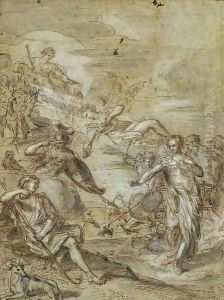Daniele Seiter Paintings
Daniele Seiter, born in 1647 in Bozen (now Bolzano, Italy) and deceased in 1705 in Vienna, Austria, was a Baroque painter whose career spanned across Italy and the Austrian Empire, reflecting the grandeur and dynamism of the Baroque style in his work. Although not as widely recognized as some of his contemporaries, Seiter's contributions to the art of the late 17th and early 18th centuries were significant, particularly in the realms of religious and mythological painting.
Seiter's early life and training are somewhat obscure, but it is known that he was profoundly influenced by the Venetian masters, adopting their vibrant color palette and dynamic compositions. His move to Rome in his early adulthood was a pivotal moment, exposing him to the works of the great Baroque artists of the time, such as Caravaggio, whose use of chiaroscuro (the dramatic effect of contrasting light and shadow) would become a hallmark of Seiter's own style.
Throughout his career, Daniele Seiter worked for various noble and ecclesiastical patrons, his paintings often characterized by dramatic narratives, rich coloration, and a meticulous attention to detail. His religious works, intended to inspire and educate the faithful, were imbued with emotional depth and spiritual intensity, characteristics that resonated with the Counter-Reformation's objectives to engage the viewer's senses and emotions.
Seiter's mythological subjects, on the other hand, allowed him to explore themes of love, heroism, and tragedy, showcasing his ability to convey complex human emotions and the beauty of the human form. These works often featured figures from classical mythology, rendered with a sense of drama and movement that brought these ancient stories to life for contemporary audiences.
Despite his achievements, Daniele Seiter's work fell into relative obscurity after his death in 1705. However, recent scholarship has begun to reassess his contribution to the Baroque movement, recognizing him as a skilled painter who bridged the Italian and Northern European traditions. Today, Seiter's paintings can be found in various museums and collections, where they continue to be appreciated for their beauty, technical skill, and historical value.
